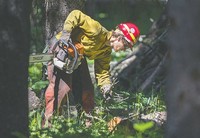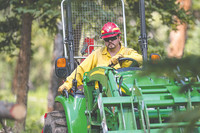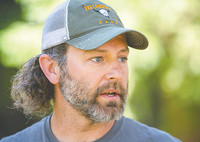Clear, 63° F
While many visitors see the burned areas as scars, the team wants you to know the area has been shaped by naturally occurring fires for thousands of years. The National Park Service currently manages the park under the credo that Yellowstone isn’t …
This item is available in full to subscribers.
The Powell Tribune has expanded its online content. To continue reading, you will need to either log in to your subscriber account, or purchase a subscription.
If you are a current print subscriber, you can set up a free web account by clicking here.
If you already have a web account, but need to reset it, you can do so by clicking here.
If you would like to purchase a subscription click here.
Please log in to continue |
|




As summer heats up, the Northeast Entrance of Yellowstone National Park echoes with the sound of chainsaws chewing through wood. After 100 square miles of the park burned last year — the most since 1988 — the Wildland Fire Management Program team has kicked into high gear, preparing for the inevitable.
While many visitors see the burned areas as scars, the team wants you to know the area has been shaped by naturally occurring fires for thousands of years. The National Park Service currently manages the park under the credo that Yellowstone isn’t a museum; it’s a functioning ecosystem in which fire plays a vital role.
Yet the wildland fire team is also responsible for the portion of the park that’s considered developed with roads, buildings and infrastructure — about 2 percent of the park’s 2.2 million acres. Preparing defensible areas is hot, dangerous work — and necessary.
“We have employees that live here. These are their homes,” said John Cataldo, Yellowstone fire management officer. “It’s our responsibility to do what we can to create defensible space so firefighters can come in here in the event of an emergency and have a fighting chance.”
Currently the team is working the area surrounding employee residences just around the corner from the Northeast Entrance. It’s the third treatment the area has gone through; the first work included 12 acres in 2003, followed up with another 12 acres in 2009 and now a third treatment. It includes more work on the canopy and dead and down trees in the two previously treated areas and an additional 10 acres across the road from the residences. The team is also attacking other 10-acre projects, including the Tower and Mammoth areas of the park.
The area near the Northeast Entrance is lush and hasn’t had a large fire since 1988.
“A lot of people come into the park and say there’s a lot of wood or timber. But if you talk to people in fire management, they’re going to say, ‘This is fuel,’” said Jonathan Shafer, a public information officer for the park.
Zac Allen, on loan from Wayne National Forest in southern Ohio for his fourth season at Yellowstone, is a fuel specialist. He loves trees — a tattoo of the outline of an oak leaf on his right arm is a testament to his passion. He’s equally passionate about working in the nation’s premiere park.
“Yellowstone is the big leagues,” Allen said.
The three previous years he was brought in from the Buckeye state to help fight fires. But this year, the team didn’t wait for a fire to begin to bring in Allen. He now supervises a tough crew of hardcore firefighters clearing the dead and fallen trees — the fuel that can turn a small fire tragic, according to Allen.
“We’re trying to reduce the chances for a large fire here,” he said. “If it comes to this area, it will be more manageable.”
So far, the 2017 season has been quiet. Only one fire has been detected and fire danger in the park is rated as moderate. The year has had more precipitation than average, mostly in snowfall, yet the effects can be deceptive. More growth means more fuel when the summer sun dries out the vegetation.
“It’s still pretty green,” Cataldo said. “We’re going out every week and physically measuring [the moisture].”
One concern is the amount of fires started by humans. The one fire started this year was caused by humans in late spring. About 20 percent of fires tracked for the past 40 years have been attributed to humans, many by backcountry hikers and trespassers, according to Cataldo.
“We average 27 fires a year. Five of those are human starts,” Cataldo said.
Backcountry hikers are required to build fires in specified campsite fire rings, but some ignore the rules. Others fail to fully put out fires before abandoning their site.
“We’ve had several incidents of backcountry visitors improvising a fire ring and then abandoning that campfire before it was cold to the touch,” Cataldo said.
Cutting down the number of human starts is a priority for the team.
Most fires in the park are started by lightning strikes.
The National Fire Protection Association, in cooperation with the U.S. Forest Service, the U.S. Department of the Interior and the National Association of State Foresters, offers the Firewise USA program. The program encourages solutions for safety by involving homeowners in taking individual responsibility for preparing their homes from the risk of wildfire.
For more information visit www.nfpa.org.